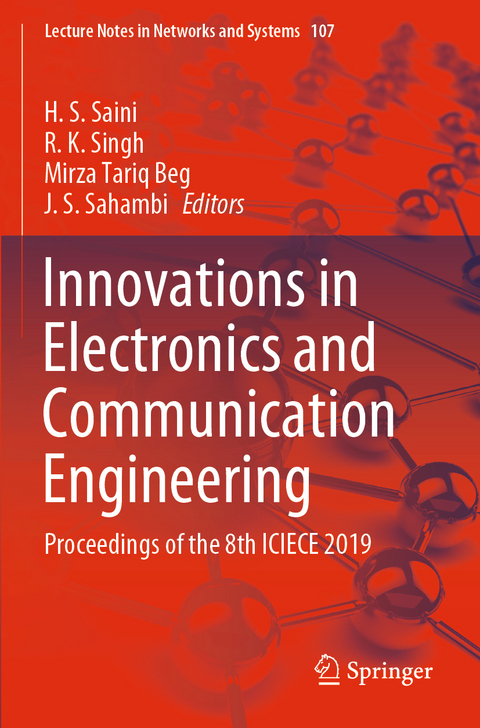
Innovations in Electronics and Communication Engineering
Springer Verlag, Singapore
978-981-15-3174-3 (ISBN)
H. S. Saini, Managing Director of Guru Nanak Institutions, obtained his Ph.D. in the field of Computer Science. He has over 22 years of experience at university/college level in teaching UG/PG students and has guided several B.Tech., M.Tech. and Ph.D. projects. He has published/presented more than 30 high-quality research papers in international, national journals and proceedings of international conferences. He is the editor for Journal of Innovations in Electronics and Communication Engineering (JIECE) published by Guru Nanak Publishers. He has two books to his credit. Dr. Saini is a lover of innovation and is an advisor for NBA/NAAC accreditation process to many Institutions in India and abroad. R. K. Singh, Associate Director Guru Nanak Institutions Technical Campus, is an alumina of REC (now MNIT Jaipur) and did his M.Tech. from IIT Bombay, in the field of Communication Engineering. He has completed Ph.D. on Radar Signal Processing from GITAM Deemed to be University. He has served Indian Army in the core of Electronics and Mechanical Engineering for 20 years before hanging his uniform as Lt Col. He has rich industrial experience as Army Officer managing workshops and has been teaching faculty for more than six years while in services. He started his career as a teaching Assistant at MNIT Jaipur for one year before joining army. As a Professor, he has served for more than eleven years after premature retirement from the army services. He has served as HOD, Vice Principal and Principal of engineering college before being approved as Associate Director of this institute. The Professor had hands-on experience on high-tech electronic equipments and has done many courses on radars and simulators. He has published many papers on microstrip antennas, VLSI and radar signal processing in national and international conferences. Mirza Tariq Beg is a Professor and Head Department of Electronics and Communication Engineering, Faculty of Engineering and Technology, Jamia Millia Islamia, New Delhi. He received Ph.D. degree from Jamia Millia Islamia New Delhi in the year 2003, M.Tech. from Delhi University Delhi in the year 1987 and B.Tech. from Aligarh Muslim University Aligarh in 1985. He started his career as an Assistant Professor in the Department of Electronics and Communication Engineering from Jamia Millia Islamia New Delhi in 1987. Now, he is working as a Professor since 2003 in the same organization. He was also Director of Centre for Distance & Open Learning (CDOL), Jamia Millia Islamia, New Delhi. His research area includes microwave and communication engineering. He has guided several Ph.D. students and authored and co-authored more than 50 research papers in peer-reviewed, international journals. J. S. Sahambi received the graduation degree in electrical engineering from Guru Nanak Engineering College, Ludhiana, India, M.Tech. degree in computer technology from the Electrical Engineering Department and the Ph.D. degree in the area of signal processing, in 1998, both from the Indian Institute of Technology (IIT) Delhi, India. In June 1999, he joined Electronics & Communication Engineering Department, IIT Guwahati, and moved to the Department of Electrical Engineering, IIT Ropar, since 2010. His research interests include signal processing, image processing, wavelets, DSP embedded systems and biomedical systems.
Chapter 1. Fault Analysis for Light Weight Block Cipher and Security Analysis in Wireless Sensor Network for Internet of Things.- Chapter 2. A Literature Review on Third Generation Solid State Drives.- Chapter 3. Simulink Model of Wireless Sensor Network in Biomedical Application.- Chapter 4. Analysis of Power in Medium Access Control Code Division Multiple Access Protocol for Data Collection in a Wireless Sensor Network.- Chapter 5. Single Feed Right Hand Circularly Polarized Microstrip Antenna with Endfire Radiation.- Chapter 6. Flexible RFID Tag Antenna Design.- Chapter 7. Miniaturized Two-Section Branch-Line Coupler Using Open-Stub Slow-Wave Structure.- Chapter 8. Implementation of Wireless Sensor Network using Virtual Machine (VM) for Insect Monitoring.-Chapter 9. Impact of Pointing Error on the Performance of 2-D WH/TS OCDMA in FSO.- Chapter 10. Millimeter wave AWR1642 RADAR for Obstacle Detection: Autonomous Vehicles.
| Erscheinungsdatum | 30.04.2021 |
|---|---|
| Reihe/Serie | Lecture Notes in Networks and Systems ; 107 |
| Zusatzinfo | 386 Illustrations, color; 133 Illustrations, black and white; XXVIII, 801 p. 519 illus., 386 illus. in color. |
| Verlagsort | Singapore |
| Sprache | englisch |
| Maße | 155 x 235 mm |
| Themenwelt | Mathematik / Informatik ► Informatik |
| Technik ► Elektrotechnik / Energietechnik | |
| Technik ► Nachrichtentechnik | |
| ISBN-10 | 981-15-3174-9 / 9811531749 |
| ISBN-13 | 978-981-15-3174-3 / 9789811531743 |
| Zustand | Neuware |
| Haben Sie eine Frage zum Produkt? |
aus dem Bereich


